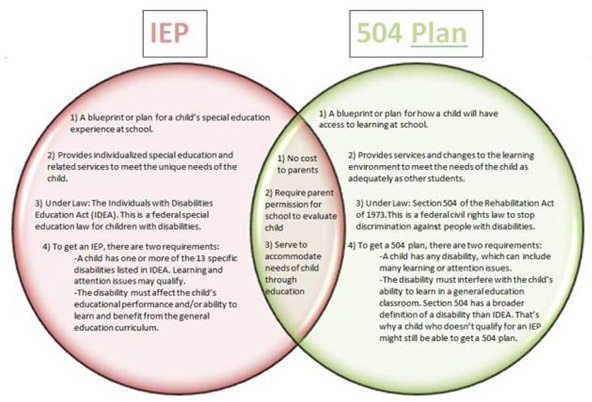A common question that is asked of us is “does my child require an IEP or will a 504 Plan provide the necessary support?” However, to answer that question one must answer the following “what is the difference between a 504 Plan and an IEP?”
What is 504 Plan?
In 1973 Congress prohibited discrimination against persons with disabilities in the Rehabilitation Act of 1973, in a segment most often referred to simply as “Section 504.” Section 504 is a federal civil rights law and prohibits discrimination by school districts receiving federal financial assistance against persons with disabilities. It states that all public schools are required to identify, evaluate, and provide appropriate services and procedural safeguards for students with disabilities.
Section 504 prohibits discrimination against individuals whose physical or mental impairment substantially limits one or more major life activities, including:
- Caring for one’s self
- Performing manual tasks
- Walking
- Seeing
- Hearing
- Speaking
- Breathing
- Working
- Learning
The determination of whether an impairment substantially limits a major life activity is made based on the impact that impairment has or would have without the effects of mitigating measures such as: medication, medical supplies, prosthetics, hearing aids, mobility devices, or oxygen therapy equipment.
Examples of impairments which may entitle an individual to 504 protection include:
- diseases such as AIDS or hepatitis B;
- medical conditions such as chronic asthma, diabetes, or epilepsy;
- physical disabilities such as cerebral palsy or muscular dystrophy;
- Attention deficit disorder with or without hyperactivity;
- alcohol/drug addicted students (does not protect individuals who are currently using drugs or alcohol);
- students with temporary disabilities; and
- students with pregnancy related complications.
It is important to remember that the presence of one of these conditions in itself does not qualify an individual for 504 protection. The impairment must also cause a substantial limitation of a major life activity. Furthermore, protections apply to students who have a recorded history of impairment and those regarded as having an impairment.
What is an IEP?
An IEP (Individualized Education Program) is a document outlining the supports and services that will be used to support an individual student who is being served through Special Education. Special education is the practice of educating students with special needs in a way that addresses their individual differences and needs. IEP’s involve the individually planned and systematically monitored arrangement of teaching procedures, adapted equipment and materials, and accessible settings. These interventions are designed to help learners with special needs achieve a higher level of personal self-sufficiency and success in school and their community, than may be available if the student were only given access to a typical classroom education.
The Individuals with Disabilities Education Act (IDEA) is the federal law that requires schools to serve the educational needs of eligible students with disabilities. Schools must evaluate students suspected of having disabilities, including learning disabilities. It is important to know that not every child with learning and attention issues qualifies for special education services under IDEA. The process of determining one’s eligibility for special education services is a lengthy process involving much legality and therefore will be discussed in more detail in a later post.
Areas of Special Education Eligibility in the State of Georgia include:
- Autism spectrum disorder
- Deaf Blind
- Deaf/hard of hearing
- Emotional and behavioral disorder
- Intellectual disability (mild, moderate, severe, profound)
- Orthopedic impairment
- Other health impairment
- Significant developmental delay
- Specific learning disability
- Speech-language impairment
- Traumatic brain injury
- Visual impairment
Differences between a 504 and an IEP
The basic distinction between a 504 and an IEP is that a 504 Plan only provides a student with accommodations to the general education setting and environment whereas an IEP provides both environmental accommodations and curriculum modifications. If a student is performing at (or is capable of performing at) a level that is consistent with his/her peers but needs some changes to his/her environment in order to be successful, then that may warrant a 504 Plan.
If a student’s disability impedes their ability to learn at a rate consistent with his/her peers, then an IEP may be more appropriate.

I’ll use ADHD as an example because it is the most common disability that brings forth this question since it could warrant either a 504 Plan or an IEP. A student with ADHD who reads on grade level but requires additional time to take tests due to his/her tendency to lose focus may benefit from a 504 Plan. Whereas a student with ADHD who cannot focus long enough to attend to the teacher’s lesson and is therefore reading substantially below grade level may necessitate an IEP and should be evaluated to determine eligibility.
Bottom line…if you’re not sure whether a 504 Plan or an IEP is more appropriate ask yourself this question “does the student require specialized instruction in order to be successful?” If the answer is no then you may want to look towards a 504 Plan. If the answer is yes you may want to seek referral for special education evaluation.
a comprehensive approach to wellness